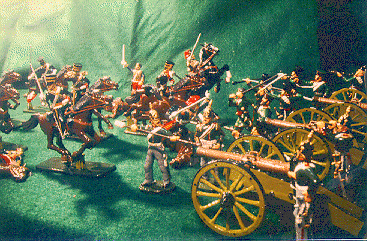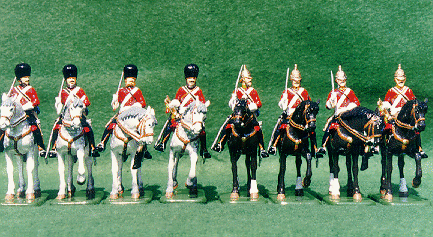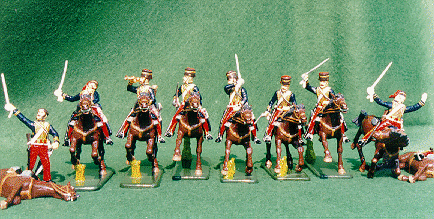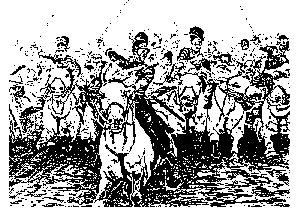
The British Cavalry Division at Balaclava 1854



In March 1854, orders were issued for the formation of an expeditionary force to be sent to the aid of Turkey, then being invaded by Russia.
The regular British line cavalry at the time consisted of:
Seven Regiments of (heavy) Dragoon Guards (1st to 7th)
Three Regiments of (heavy) Dragoons (1st, 2nd and 6th)
Four Regiments of (light) Dragoons (3rd, 4th 13th and 14th)
Five Regiments of Hussars (7th, 8th, 10th, 11th and 15th)
Four Regiments of Lancers (9th, 12th, 16th and 17th)
Due to reductions forced through economies, the total manpower of the Regiments was 10,600 of which some 3,000 were serving in India.
Traditionally, European Cavalry had been divided into three classes, Heavy, Dragoons and Light:-


By 1854, these distinctions had largely been lost in the British Army, mainly due to economic reasons, and the duties of the Heavy and Light Cavalry were mainly equal. These regiments were selected to form the cavalry of the expeditionary force. Five were so called Heavies the 4th and 5th Dragoon Guards, and the 1st and 2nd and 6th Dragoons; and five were Light Cavalry, the 4th and 13th Light Dragoons the 8th and 11th Hussars and the 17th Lancers. The difficulties encountered in assembling the force were formidable, but eventually the sailing transports left taking from three to six weeks to reach the Bosphorous, and a further two days to Varna on the Black Sea coast of Bulgaria. The effect of the journey upon the horses can be imagined, one regiment the 6th Inniskilling Dragoons losing 57 horses, and with only the RSM and 11 men surviving a disastrous fire that broke out in their transport, the Europa, only 200 miles out from Plymouth.
Following arrivals, at Varna, from the 31st May to 4th August, various reconnoisance, patrols and exercises were undertaken, and at the end of August orders were issued to prepare the whole force for embarkation, and on September 7th 1854, the British Flotilla left Varna for the Crimea.
The order of Battle of the British Cavalry first mentioned in General Orders on 2nd May stated:
Cavalry Division.
Major General the Earl of Lucan,
1st Brigade of Cavalry. Brigadier General the Earl of Cardigan, 11th Hussars, 9th Light Dragoons, 8th Hussars, 11th Hussars, 13th Light Dragoons, 17th Lancers.
2nd Brigade of Cavalry. Brigadier General the Hon. J Y Scarlett, 5th Dragoon Guards, 4th Dragoon Guards. 5th Dragoon Guards, 1st Royal Dragoons, 2nd Royal North British Dragoons, 6th Inniskilling Dragoons.
The force landed on an open beach some 30 miles North of Sebastopol in Kalamita Bay, commencing on 14th September 1854. There followed a period of serious organisational difficulties, sickness, including cholera, inept skirmishes and patrols, none the least being that known as "The Bulganak Affair' on the l9th September, when not only Lord Cardigan, but also Lords Lucan and Raglan together with General Airey, showed their lack of practical field experience.
The Battle of Alma, and by the 25th September the so called 'Flank March' and McKenzie's Farm, further revealed the inexperience of the Cavalry Officers, but from the 25th September, the force was encamped on a large plateau, facing North and preparing for the first bombardment of Sebastopol.
Four miles to the rear lay the small town of Balaclava, through which the British supplies had to pass. From the head of the harbour was a grassy undulating place North East from the Tchernaya River, the plain itself some half a mile north of Balaclava, was bounded by a range of low hillocks extending west for nearly three miles from the village of Kamara. Along this ridge known as the Causeway Heights ran the 'Worontsoff Road'. Across the south valley lay the village of Kadikoi, and it was in the valley that the cavalry established itself with the heavy cavalry sharing piquet and outpost duty. To the north was North Valley, the scene of the Charge of the Light Brigade with the Sapoune Ridge and the Fedioakine Hills forming the Northern background to the battle whilst the Russian guns were to the east of the valley. Early on the morning of 25th October, following a Russian assault on the Eastern end of the redoubts, they soon carried redoubt No 1 (Canroberrs Hill) through redoubts 4 - 5 and with the Heavy Brigade counter attacking, the Light Brigade established itself at the Eastern end of the valley with Lord Raglan and Canroberts on the Sapoune Ridge.
At about 9.30 am the Russians consolidated their positions around redoubts 1 - 3 while their cavalry halted and reformed behind the protection of a battery of Don Cossack Horse Artillery.
Ordered by Lord Raglan, Lord Lucan assumed that he was to support an infantry attack and moved the Light Brigade up the North valley as far as the No 4 Redoubt. Lord Raglan from his elevated position could see Russian artillery teams moving forward, and assumed they were about to capture British guns abandoned in the redoubts, and he therefore ordered his Quartermaster, General Airey to send the order to Lord Lucan:
"Lord Raglan wishes the cavalry to advance rapidly to the front, follow the enemy and try to prevent he enemy carrying away the guns. Troop Horse Artillery may accompany. French Cavalry is on your left. Immediate."
On receiving this order from Captain Nolan the only guns Lucan could see were those attached to the Russian Cavalry at the far end of the North valley. "There my Lord, are your guns, there are the enemy." Nolan impatiently exclaimed with a sweep of his arm which took in the greater part of the Russian position
This order passed to Lord Cardigan who commented, "Well there goes the last of the Brudeneils" and led the Brigade forward at a trot. Thus commenced the famous Charge, the 8th and 11th Hussars, 4th and 13th Light Dragoons and the 17th Lancers, writing a page of military history that has thrilled generations to this day.
All order was lost, and the spectators on the Supoune Heights saw only a few stragglers emerging from the smoke filled valley. In fact, 371 of the 658 men involved survived, with a loss of some 362 horses. The losses among the horses were almost certainly higher, as many were put down later. According to one source 113 were all that were left, and the majority of these were to die from exposure and starvation during the following winter. Effectively, the 5 regiments were ineffective as a fighting force as a result of the Charge.
FRONTLINE FIGURES have modelled every Regirnent present on that fateful day in October 1854, and for the serious collector and student of Military History the superb collection builds into a representation of both the British and Russian forces that took part in a classic action that is proudly reflected in the Battle Honours of these famous Regiments.

Extracts abridged from 'Into the Valley of Death' by John Boris Mollo published by Windrow & Greene, London